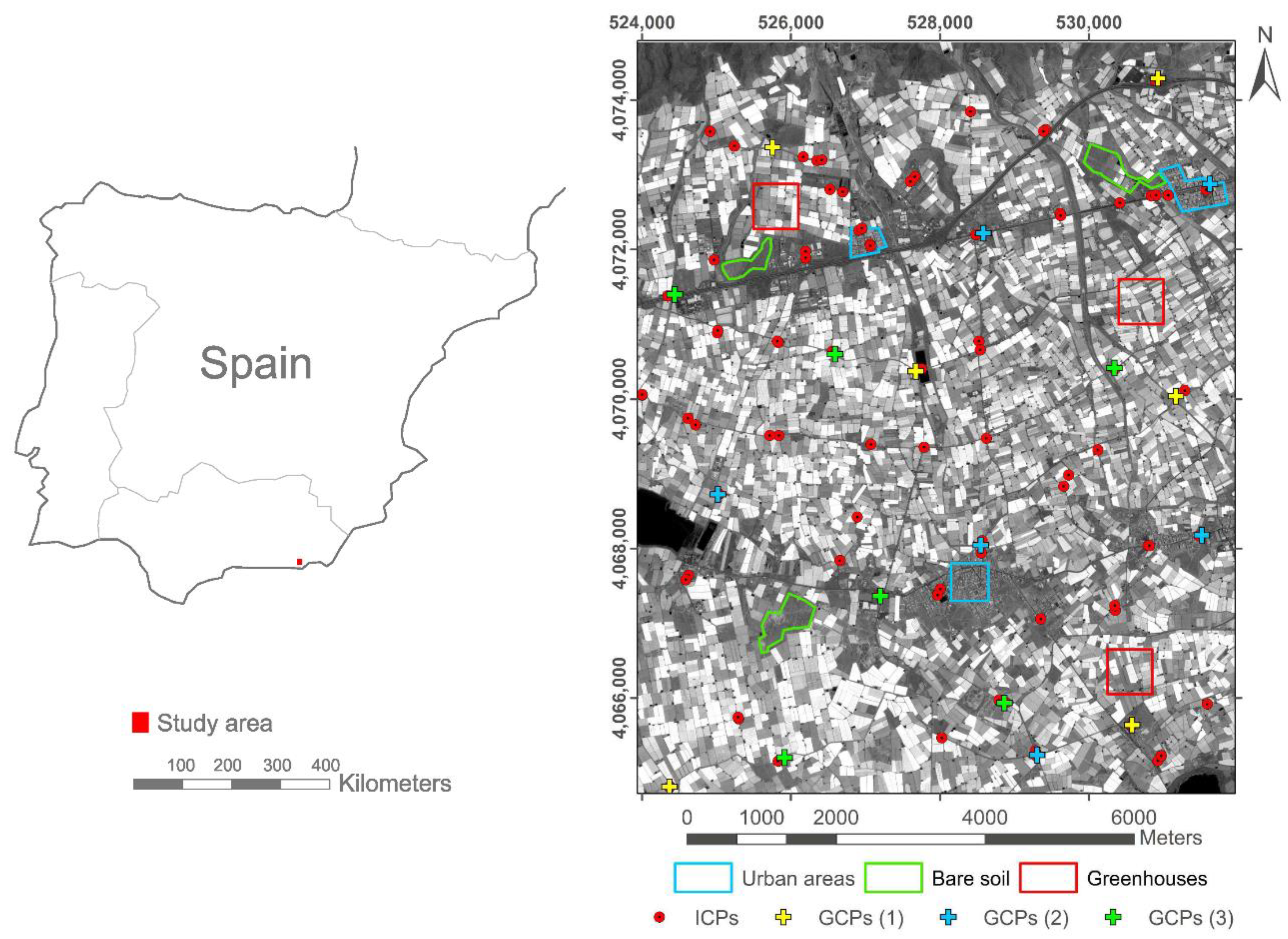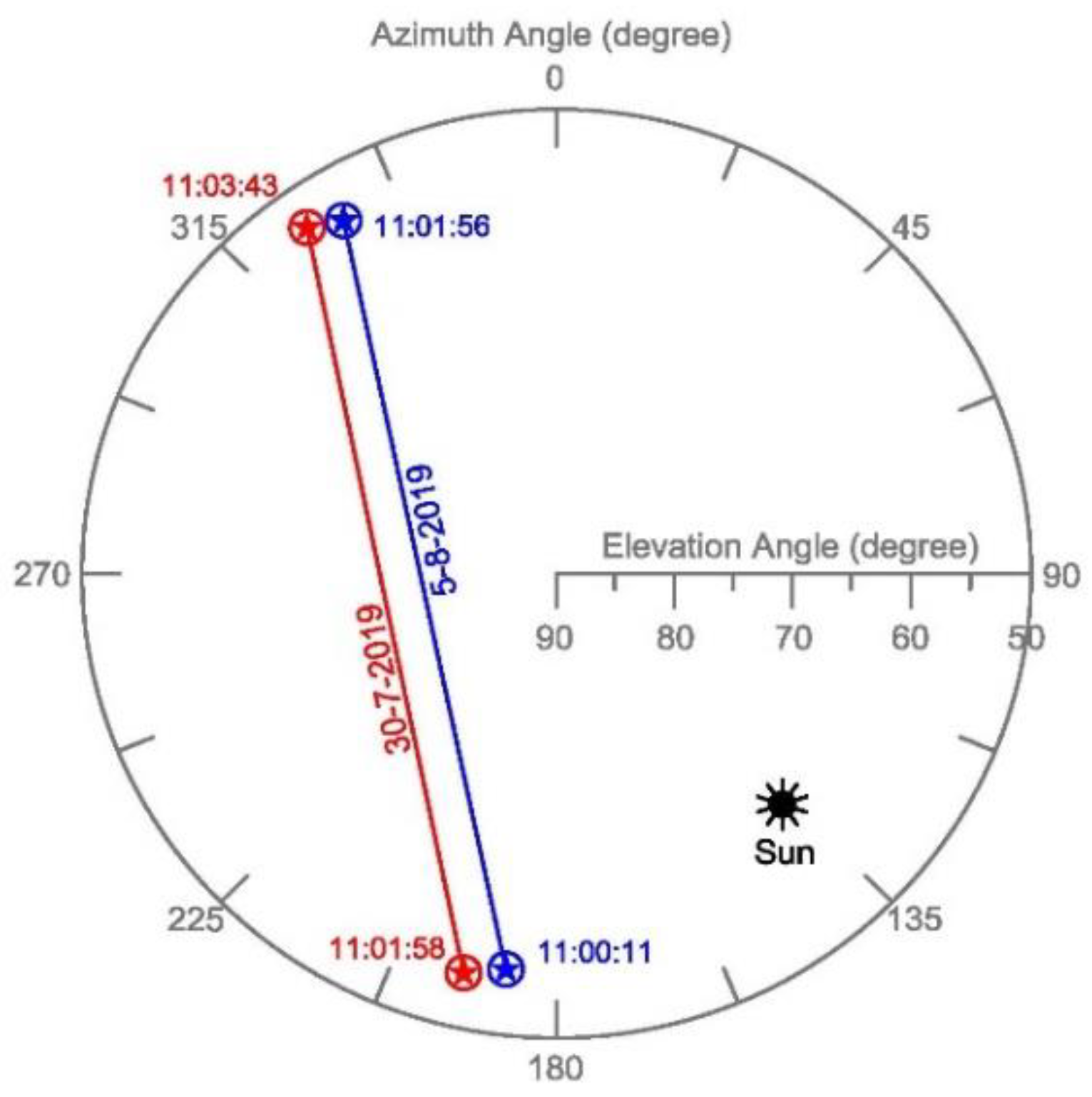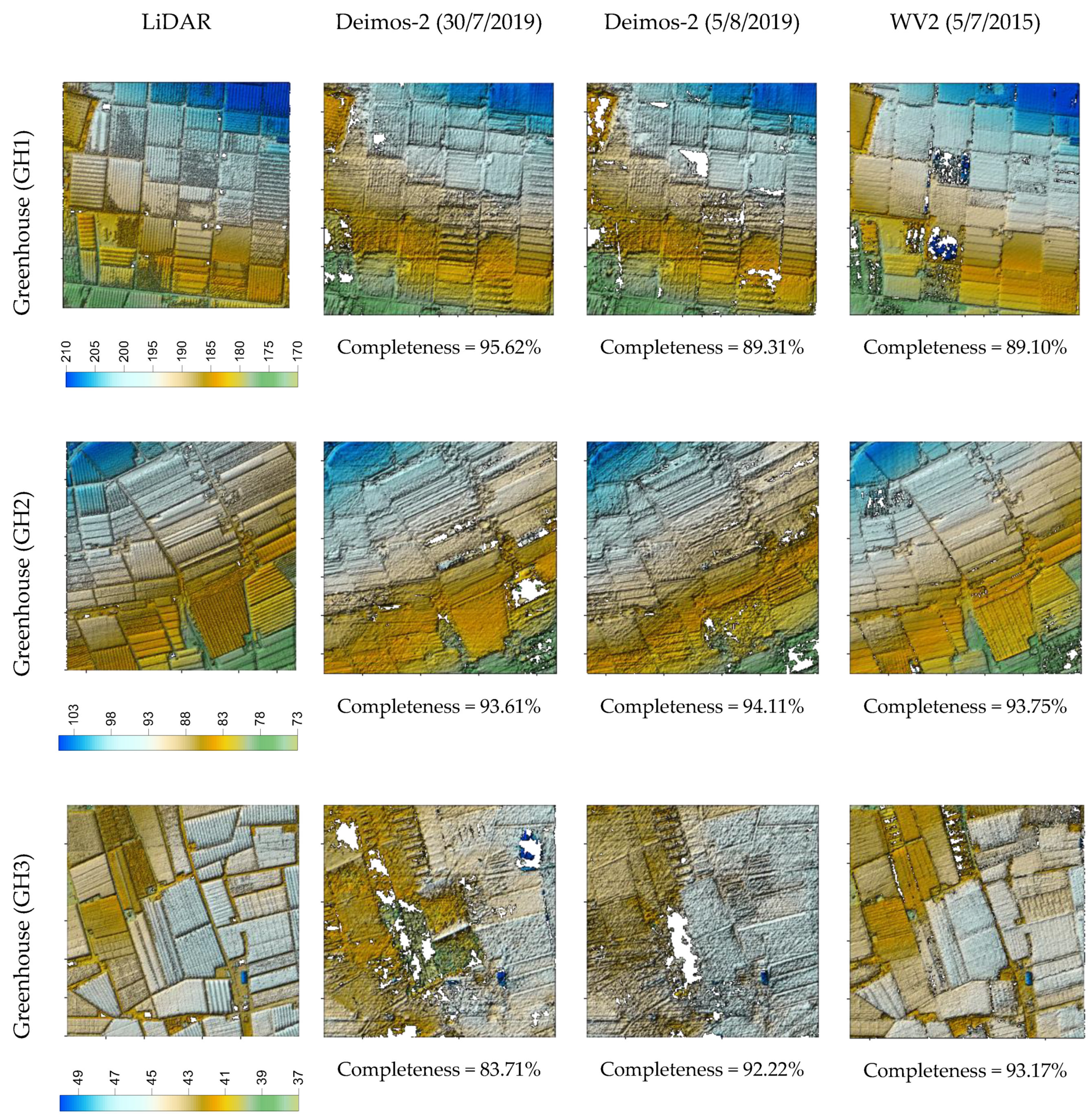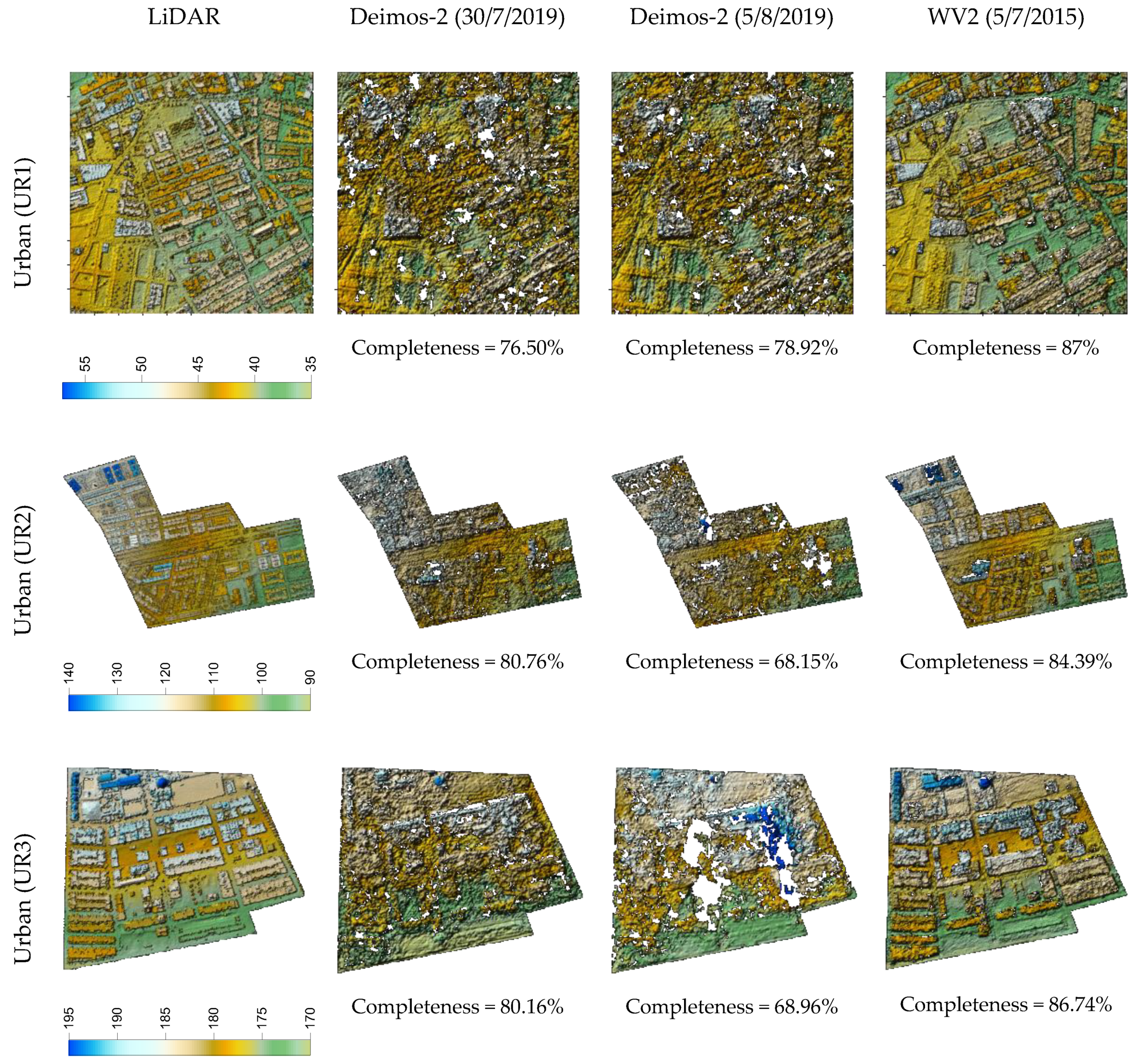Geometric Accuracy Assessment of Deimos-2 Panchromatic Stereo Pairs: Sensor Orientation and Digital Surface Model Production
Abstract
1. Introduction
2. Study Area
3. Datasets
3.1. Ground Points Collection
3.2. Deimos-2 Stereo Pairs
3.3. WorldView-2 Stereo Pair
3.4. Reference LiDAR Data
4. Methods
4.1. Sensor Orientation
- (i)
- Direct geopositioning was performed without using GCPs, thus taking the 102 GPs as ICPs in the corresponding four independent projects created in OrthoEngine. In this way, the images were orientated only using the supplied RPCs. Geometric accuracies were computed from the residuals attained at the 102 ICPs and presented as mean error (bias), standard deviation (SD) and RMSE, computed both through X and Y axes, and as planimetric values (2D).
- (ii)
- The all GPs as GCPs strategy meant using all 102 GPs as GCPs (i.e., without ICPs). Transformations of zero (RPC0), first (RPC1) and second (RPC2) order polynomial adjustments were applied. Geometric accuracies were calculated using the residuals from those 102 GCPs.
- (iii)
- Regarding the operational approach with a few GCPs, three sets of GCPs were chosen to carry out the georeferencing: 6 GCPs (set GCP 1 in Figure 1), 12 GCPs (set GCP 1 plus set 2 in Figure 1), and 18 GCPs (set GCP 1 plus set 2 plus set 3 in Figure 1). Each of these variations of the number of GCPs were tested with the three sensor models mentioned above (i.e., RPC0, RPC1 and RPC2). In total, 36 RMSE2D values were computed (i.e., four single Deimos-2 images × three sets of GCPs (6, 12 and 18) × three sensor models (RPC0, RPC1 and RPC2)). In each case, the remaining GPs were considered ICPs (i.e., 96 ICPs when using 6 GCPs, 90 ICPs when using 12 GCPs, and 84 ICPs when using 18 GCPs) to calculate the corresponding geometric accuracies (bias, SD and RMSE).
4.2. DSM Extraction
5. Results
5.1. Sensor Orientation
5.2. Quality Assessment of the Extracted DSMs
6. Discussion
6.1. Sensor Orientation of Deimos-2 Images
6.2. Quality Assessment of the Extracted DSMs
7. Conclusions
Author Contributions
Funding
Acknowledgments
Conflicts of Interest
References
- Fraser, C.; Hanley, H.B. Bias compensation in rational functions for ikonos satellite imagery. Photogramm. Eng. Remote Sens. 2003, 69, 53–57. [Google Scholar] [CrossRef]
- Toutin, T. Error tracking in ikonos geometric processing using a 3D parametric model. Photogramm. Eng. Remote Sens. 2003, 69, 43–51. [Google Scholar] [CrossRef]
- Aguilar, M.A.; Aguilar, F.J.; Agüera, F.; Sánchez, J.A. Geometric accuracy assessment of quickBird basic imagery using different qperational approaches. Photogramm. Eng. Remote Sens. 2007, 73, 1321–1332. [Google Scholar] [CrossRef]
- Fraser, C.S.; Ravanbakhsh, M. Georeferencing accuracy of geoEye-1 imagery. Photogramm. Eng. Remote Sens. 2009, 75, 634–638. [Google Scholar]
- Aguilar, M.A.; Aguilar, F.J.; Saldaña, M.D.M.; Fernández, I. Geopositioning accuracy assessment of geoEye-1 panchromatic and multispectral imagery. Photogramm. Eng. Remote Sens. 2012, 78, 247–257. [Google Scholar] [CrossRef]
- Åstrand, P.J.; Bongiorni, M.; Crespi, M.G.; Fratarcangeli, F.; Da Costa, J.N.; Pieralice, F.; Walczynska, A. The potential of WorldView-2 for ortho-image production within the “Control with Remote Sensing Programme” of the European Commission. Int. J. Appl. Earth Obs. Geoinf. 2012, 19, 335–347. [Google Scholar] [CrossRef]
- Aguilar, M.A.; Saldaña, M.D.M.; Aguilar, F.J. Assessing geometric accuracy of the orthorectification process from GeoEye-1 and WorldView-2 panchromatic images. Int. J. Appl. Earth Obs. Geoinf. 2013, 21, 427–435. [Google Scholar] [CrossRef]
- Parente, C.; Belfiore, O.R. Orthorectification and pan-sharpening of worldview-2 satellite imagery to produce high resolution coloured ortho-photos. Mod. Appl. Sci. 2015, 9, 122. [Google Scholar] [CrossRef][Green Version]
- Poli, D.; Remondino, F.; Angiuli, E.; Agugiaro, G. Radiometric and geometric evaluation of GeoEye-1, WorldView-2 and Pléiades-1A stereo images for 3D information extraction. ISPRS J. Photogramm. Remote Sens. 2015, 100, 35–47. [Google Scholar] [CrossRef]
- Barbarella, M.; Fiani, M.; Zollo, C. Assessment of DEM derived from very high-resolution stereo satellite imagery for geomorphometric analysis. Eur. J. Remote Sens. 2017, 50, 534–549. [Google Scholar] [CrossRef]
- Loghin, A.-M.; Otepka, J.; Pfeifer, N. Potential of pléiades and worldview-3 tri-stereo DSMs to represent heights of small isolated objects. Sensors 2020, 20, 2695. [Google Scholar] [CrossRef] [PubMed]
- Grodecki, J.; Dial, G. Block Adjustment of high-resolution satellite images described by rational polynomials. Photogramm. Eng. Remote Sens. 2003, 69, 59–68. [Google Scholar] [CrossRef]
- Fraser, C.; Hanley, H.B. Bias-compensated RPCs for sensor orientation of high-resolution satellite imagery. Photogramm. Eng. Remote Sens. 2005, 71, 909–915. [Google Scholar] [CrossRef]
- Khateri, M.; Shabanzade, F.; Mirzapour, F.; Zaji, A.; Liu, Z. A variational approach for fusion of panchromatic and multispectral images using a new spatial–spectral consistency term. IEEE J. Sel. Top. Appl. Earth Obs. Remote Sens. 2020, 13, 3421–3436. [Google Scholar] [CrossRef]
- Gao, G.; Gu, Y. Tensorized principal component alignment: A unified framework for multimodal high-resolution images classification. IEEE Trans. Geosci. Remote Sens. 2018, 57, 46–61. [Google Scholar] [CrossRef]
- Vajsová, B.; Moclán, C.; Åstrand, P.J.; Fabrizi, R. Geometry Benchmark of DEIMOS-2 for the CAP Control with Remote Sensing; JCR Technical Report EUR 28258; Publications Office of the European Union: Luxembourg, 2016. [Google Scholar]
- Hirschmuller, H. Stereo processing by semiglobal matching and mutual information. IEEE Trans. Pattern Anal. Mach. Intell. 2008, 30, 328–341. [Google Scholar] [CrossRef]
- Mandanici, E.; Girelli, V.A.; Poluzzi, L. Metric accuracy of digital elevation models from worldview-3 stereo-pairs in urban areas. Remote Sens. 2019, 11, 878. [Google Scholar] [CrossRef]
- Aguilar, M.A.; Nemmaoui, A.; Aguilar, F.J.; Qin, R. Quality assessment of digital surface models extracted from WorldView-2 and WorldView-3 stereo pairs over different land covers. GISci. Remote Sens. 2018, 56, 109–129. [Google Scholar] [CrossRef]
- Nemmaoui, A.; Aguilar, F.J.; Aguilar, M.A.; Qin, R. DSM and DTM generation from VHR satellite stereo imagery over plastic covered greenhouse areas. Comput. Electron. Agric. 2019, 164, 104903. [Google Scholar] [CrossRef]
- Han, Y.; Qin, R.; Huang, X. Assessment of dense image matchers for digital surface model generation using airborne and spaceborne images—An update. Photogramm. Rec. 2020, 35, 58–80. [Google Scholar] [CrossRef]
- Reinartz, P.; D’Angelo, P.; Krauß, T.; Poli, D.; Jacobsen, K.; Buyuksalih, G. Benchmarking and quality analysis of DEM generated from high and very high resolution optical stereo satellite data. Int. Arch. Photogramm. Remote Sens. Spat. Inf. Sci. 2010, 38, 6. [Google Scholar]
- Qin, R. RPC Stereo Processor (RSP)—A software package for digital surface model and orthophoto generation from satellite stereo imagery. ISPRS Ann. Photogramm. Remote Sens. Spat. Inf. Sci. 2016, 77–82. [Google Scholar] [CrossRef]
- Stylianidis, E.; Akça, M.D.; Poli, D.; Hofer, M.; Gruen, A.; Martin, V.S.; Smagas, K.; Walli, A.; Altan, O.; Jimeno, E.; et al. FORSAT: A 3D forest monitoring system for cover mapping and volumetric 3D change detection. Int. J. Digit. Earth 2020, 13, 854–885. [Google Scholar] [CrossRef]
- Rupnik, E.; Pierrot-Deseilligny, M.; Delorme, A. 3D reconstruction from multi-view VHR-satellite images in MicMac. ISPRS J. Photogramm. Remote Sens. 2018, 139, 201–211. [Google Scholar] [CrossRef]
- Wang, S.; Ren, Z.; Wu, C.; Lei, Q.; Gong, W.; Ou, Q.; Zhang, H.; Ren, G.; Li, C. DEM generation from Worldview-2 stereo imagery and vertical accuracy assessment for its application in active tectonics. Geomorphology 2019, 336, 107–118. [Google Scholar] [CrossRef]
- Fieber, K.D.; Mills, J.P.; Miller, P.E.; Clarke, L.; Ireland, L.; Fox, A.J. Rigorous 3D change determination in Antarctic Peninsula glaciers from stereo WorldView-2 and archival aerial imagery. Remote Sens. Environ. 2018, 205, 18–31. [Google Scholar] [CrossRef]
- Höhle, J.; Potuckova, M. The EuroSDR test: Checking and improving of digital terrain models. In European Spatial Data Research; Gopher: Utrecht, The Netherlands, 2006; pp. 9–141. [Google Scholar]
- Capaldo, P. DSM generation from high resolution imagery: Applications with WorldView-1 and Geoeye-1. Ital. J. Remote Sens. 2012, 44, 41–53. [Google Scholar] [CrossRef]
- Noh, M.-J.; Howat, I.M. Automated stereo-photogrammetric DEM generation at high latitudes: Surface Extraction with TIN-based Search-space Minimization (SETSM) validation and demonstration over glaciated regions. GISci. Remote Sens. 2015, 52, 198–217. [Google Scholar] [CrossRef]
- Noh, M.-J.; Howat, I.M. The Surface Extraction from TIN based Search-space Minimization (SETSM) algorithm. ISPRS J. Photogramm. Remote Sens. 2017, 129, 55–76. [Google Scholar] [CrossRef]
- Toutin, T. Comparison of 3D physical and empirical models for generating DSMs from stereo HR images. Photogramm. Eng. Remote Sens. 2006, 72, 597–604. [Google Scholar] [CrossRef]
- Aguilar, M.A.; Vallario, A.; Aguilar, F.J.; Lorca, A.M.G.; Parente, C. Object-based greenhouse horticultural crop identification from multi-temporal satellite imagery: A case study in Almeria, Spain. Remote Sens. 2015, 7, 7378–7401. [Google Scholar] [CrossRef]
- Li, R.; Zhou, F.; Niu, X.; Di, K. Integration of ikonos and quickbird imagery for geopositioning accuracy analysis. Photogramm. Eng. Remote Sens. 2007, 73, 1067–1074. [Google Scholar]
- Li, R.; Niu, X.; Liu, C.; Wu, B.; Deshpande, S. Impact of imaging geometry on 3D geopositioning accuracy of stereo ikonos imagery. Photogramm. Eng. Remote Sens. 2009, 75, 1119–1125. [Google Scholar] [CrossRef]
- Aguilar, M.A.; Saldana, M.D.M.; Aguilar, F.J. Generation and quality assessment of stereo-extracted DSM From GeoEye-1 and WorldView-2 imagery. IEEE Trans. Geosci. Remote Sens. 2014, 52, 1259–1271. [Google Scholar] [CrossRef]
- DigitalGlobe. The Benefits of the Eight Spectral Bands of WorldView-2. Available online: https://dg-cms-uploads-production.s3.amazonaws.com/uploads/document/file/35/DG-8SPECTRAL-WP_0.pdf (accessed on 9 October 2020).
- Jacobsen, K. Systematic geometric image errors of very high resolution optical satellites. ISPRS Int. Arch. Photogramm. Remote Sens. Spat. Inf. Sci. 2018, 42, 233–238. [Google Scholar] [CrossRef]
- Montealegre, A.L.; Lamelas, M.T.; Fernández, J.D.L.R. Interpolation routines assessment in ALS-Derived digital elevation models for forestry applications. Remote Sens. 2015, 7, 8631–8654. [Google Scholar] [CrossRef]
- Ministerio de Fomento de España. Plan Nacional de Ortofotografía Aérea. Available online: https://pnoa.ign.es/el-proyecto-pnoa-lidar (accessed on 9 October 2020).
- Daniel, C.; Tennant, K. DEM Quality Assessment. In Digital Elevation Model Technologies and Applications: The DEM Users Manual; ASPRS Publications: Bethesda, MD, USA, 2001; pp. 395–440. [Google Scholar]
- Snedecor, G.W.; Cochran, W.G. Statistical Methods, 7th ed.; Iowa State University Press: Ames, IA, USA, 1980. [Google Scholar]
- Aguilar, M.A.; Agüera, F.; Aguilar, F.J.; Carvajal, F.; Carvajal-Ramírez, F. Geometric accuracy assessment of the orthorectification process from very high resolution satellite imagery for Common Agricultural Policy purposes. Int. J. Remote Sens. 2008, 29, 7181–7197. [Google Scholar] [CrossRef]
- Höhle, J.; Höhle, M. Accuracy assessment of digital elevation models by means of robust statistical methods. ISPRS J. Photogramm. Remote Sens. 2009, 64, 398–406. [Google Scholar] [CrossRef]
- Spurrier, J.D. On the null distribution of the Kruskal–Wallis statistic. J. Nonparametr. Stat. 2003, 15, 685–691. [Google Scholar] [CrossRef]
- Maxar. View-Ready (2A) Imagery. Available online: https://www.digitalglobe.com/products/satellite-imagery/MXR-DS-view-ready(2a)imagery.pdf (accessed on 12 October 2020).
- Gallay, M.; Lloyd, C.D.; McKinley, J.; Barry, L. Assessing modern ground survey methods and airborne laser scanning for digital terrain modelling: A case study from the Lake District, England. Comput. Geosci. 2013, 51, 216–227. [Google Scholar] [CrossRef]





| Product | Deimos-2 Stereo Pair | Deimos-2 Stereo Pair | ||
|---|---|---|---|---|
| Acquisition date | 30 July 2019 | 30 July 2019 | 5 August 2019 | 5 August 2019 |
| Image Code | 1_1 | 1_2 | 2_1 | 2_2 |
| Acquisition time (GTM) | 11:01:58 | 11:03:43 | 11:00:11 | 11:01:56 |
| Cloud cover | 0% | 0% | 0% | 0% |
| Sun elevation | 65.438 | 65.668 | 64.068 | 64.278 |
| Sun azimuth | 132.908 | 133.718 | 134.438 | 135.238 |
| Collection elevation | 54.758 | 53.548 | 55.678 | 54.698 |
| Collection azimuth | 192.868 | 324.828 | 187.378 | 329.468 |
| Product pixel size | 1 m | 1 m | 1 m | 1 m |
| Image Code | Bias (m) | SD (m) | RMSE (m) | |||||
|---|---|---|---|---|---|---|---|---|
| X | Y | X | Y | 2D | X | Y | 2D | |
| 1_1 | 11.12 | −22.10 | 0.97 | 0.82 | 1.27 | 11.16 | 22.12 | 24.77 |
| 1_2 | 11.86 | 23.22 | 1.11 | 1.04 | 1.52 | 11.91 | 23.25 | 26.12 |
| 2_1 | 7.34 | −21.65 | 0.86 | 1.07 | 1.37 | 7.38 | 21.67 | 22.90 |
| 2_2 | 9.20 | 23.05 | 0.91 | 1.14 | 1.46 | 9.24 | 23.08 | 24.86 |
| Image Code | Sensor Model | RMSE (m) | ||
|---|---|---|---|---|
| X | Y | 2D | ||
| 1_1 | RPC0 | 0.967 | 0.812 | 1.262 |
| RPC1 | 0.770 | 0.650 | 1.008 | |
| RPC2 | 0.754 | 0.645 | 0.993 | |
| 1_2 | RPC0 | 1.106 | 1.037 | 1.516 |
| RPC1 | 0.869 | 0.842 | 1.210 | |
| RPC2 | 0.854 | 0.814 | 1.180 | |
| 2_1 | RPC0 | 0.857 | 1.062 | 1.365 |
| RPC1 | 0.803 | 0.669 | 1.045 | |
| RPC2 | 0.745 | 0.623 | 0.971 | |
| 2_2 | RPC0 | 0.902 | 1.138 | 1.452 |
| RPC1 | 0.802 | 0.730 | 1.085 | |
| RPC2 | 0.756 | 0.678 | 1.016 | |
| Sensor Model (RMSE2D (m)) | No. GCPs | ICPs | RMSE2D (m) (Mean Value of the Four Deimos-2 Images) |
|---|---|---|---|
| RPC0 (1.453 a) | 6 | 96 | 1.417 |
| 12 | 90 | 1.477 | |
| 18 | 84 | 1.467 | |
| RPC1 (1.268 b) | 6 | 96 | 1.317 |
| 12 | 90 | 1.255 | |
| 18 | 84 | 1.231 | |
| RPC2 (1.234 b) | 6 | 96 | 1.301 |
| 12 | 90 | 1.213 | |
| 18 | 84 | 1.189 |
| Land Cover | Stereo Pair | Completeness (%) | Min. (%)–Max. (%) |
|---|---|---|---|
| Plastic covered greenhouse | Deimos-2 (30 July 2019) | 90.98 | 83.61–95.62 |
| Deimos-2 (5 August 2019) | 91.88 | 89.31–94.11 | |
| WV2 (5 July 2015) | 92.00 | 89.10–93.75 | |
| Urban | Deimos-2 (30 July 2019) | 79.14 a,b | 76.50–80.76 |
| Deimos-2 (5 August 2019) | 71.01 a | 65.96–78.92 | |
| WV2 (5 July 2015) | 86.04 b | 84.39–87.00 | |
| Bare Soil | Deimos-2 (30 July 2019) | 95.96 a,b,* | 94.02–98.09 |
| Deimos-2 (5 August 2019) | 92.73 a,* | 85.38–98.58 | |
| WV2 (5 July 2015) | 99.76 b,* | 99.47–99.95 |
| Land Cover | Stereo Pair | Mean (m) | SD (m) | RMSEZ (m) | LE95 (m) | NMAD (m) |
|---|---|---|---|---|---|---|
| Plastic covered greenhouse | Deimos-2 (30 July 2019) | 0.52 (1.60, −0.58) | 1.44 a (1.78, 1.21) | 1.76 a,* | 3.59 a | 1.02 a |
| Deimos-2 (5 August 2019) | 0.30 (1.60, −0.43) | 1.19 a,b (1.31, 1.07) | 1.48 a,b,* | 2.93 ab | 0.92 a | |
| WV2 (5 July 2015) | 0.43 (0.62, 0.19) | 0.86 b (0.65, 1.11) | 0.97 b,* | 2.10 b | 0.45 b | |
| Urban | Deimos-2 (30 July 2019) | 0.04 (2.24, −1.71) | 3.16 a,b (3.63, 2.91) | 3.55 a,b | 7.50 a,b | 2.14 a |
| Deimos-2 (5 August 2019) | −0.14 (0.43, −0.63) | 3.93 a (4.69, 3.02) | 3.96 a | 8.62 a | 2.92 a | |
| WV2 (5 July 2015) | 0.37 (0.49, 0.30) | 2.16 b (3.05, 1.59) | 2.20 b | 5.38 b | 0.75 b | |
| Bare Soil | Deimos-2 (30 July 2019) | 0.04 (0.76, −1.09) | 1.06 (1.71, 0.60) | 1.32 | 2.99 | 0.81 a |
| Deimos-2 (5 August 2019) | −0.27 (0.97, −1.42) | 1.06 (1.99, 0.42) | 1.41 | 3.20 | 0.73 a,b | |
| WV2 (5 July 2015) | 0.68 (0.79, 0.61) | 0.21 (0.24, 0.19) | 0.71 | 1.03 | 0.17 b |
Publisher’s Note: MDPI stays neutral with regard to jurisdictional claims in published maps and institutional affiliations. |
© 2020 by the authors. Licensee MDPI, Basel, Switzerland. This article is an open access article distributed under the terms and conditions of the Creative Commons Attribution (CC BY) license (http://creativecommons.org/licenses/by/4.0/).
Share and Cite
Aguilar, M.A.; Jiménez-Lao, R.; Nemmaoui, A.; Aguilar, F.J. Geometric Accuracy Assessment of Deimos-2 Panchromatic Stereo Pairs: Sensor Orientation and Digital Surface Model Production. Sensors 2020, 20, 7234. https://doi.org/10.3390/s20247234
Aguilar MA, Jiménez-Lao R, Nemmaoui A, Aguilar FJ. Geometric Accuracy Assessment of Deimos-2 Panchromatic Stereo Pairs: Sensor Orientation and Digital Surface Model Production. Sensors. 2020; 20(24):7234. https://doi.org/10.3390/s20247234
Chicago/Turabian StyleAguilar, Manuel A., Rafael Jiménez-Lao, Abderrahim Nemmaoui, and Fernando J. Aguilar. 2020. "Geometric Accuracy Assessment of Deimos-2 Panchromatic Stereo Pairs: Sensor Orientation and Digital Surface Model Production" Sensors 20, no. 24: 7234. https://doi.org/10.3390/s20247234
APA StyleAguilar, M. A., Jiménez-Lao, R., Nemmaoui, A., & Aguilar, F. J. (2020). Geometric Accuracy Assessment of Deimos-2 Panchromatic Stereo Pairs: Sensor Orientation and Digital Surface Model Production. Sensors, 20(24), 7234. https://doi.org/10.3390/s20247234







